TCAT Free Fares: kids, now; grownups, someday?
by Robert Lynch, May 27, 2022
Starting Sunday, May 29th, Tompkins Consolidated Area Transit (TCAT) will begin permanently offering free rides to anyone ages 17 years and under. But a larger question looms; one far more financially ambitious: Should the local bus line provide free transportation to everybody?

It won’t happen now, but it may happen someday.
“How are we going to address equity and sustainability in our transit service?” asked John Monkovic, member of a group he identified as “Fair and Free TCAT.” He spoke during floor privileges at the start of TCAT’s monthly Board of Directors meeting Thursday (May 26). Monkovic blamed “the austerity at Cornell” for much of the problem, arguing the University should contribute an additional ten per cent of the transit service’s expenses to enable free service to all.
Monkovic’s opinion may be his own. Yet it resonated with at least one TCAT Board member, Tompkins County legislator Dan Klein.
“I’m very attracted to the fare-free ride as well,” said Klein at Thursday’s meeting, though the legislator admitted, “This may not be the best moment.”
Nonetheless, said Klein, when it comes to eventually free ridership, “We should not take our eye off the goal.”
TCAT is struggling in fighting red ink. Ridership has fallen since the pandemic began. Now the agency finds itself coping with driver shortages and the skyrocketing cost of diesel fuel.
Agreeing with Klein, the transit service’s General Manager, Scot Vanderpool, advised Board members that now is not the time to trim everyone’s fares to zero.
“The driver shortage,” Vanderpool said, “would really hamper (free service) right now, because there’d be increased demand.”
And a driver shortage there is. Figures shared at the meeting indicated that of the 165 missed trips by TCAT buses on routes during April, a full 153 were due to driver shortages. And officials clarified that the numbers don’t even include the two-day, late-April service reduction blamed on drivers being sick or otherwise unavailable.
Acting Ithaca Mayor and TCAT Board member Laura Lewis defended TCAT’s sustainability commitment, pointing to both the agency’s decision in March to provide fare-free service to youths as well as its mission to move to a full-electric fleet.
“We have a commitment to equity and the environment,” Lewis said.
During Thursday’s meeting, the TCAT Board allocated more than $1.3 Million from a pair of funds it oversees to provide a local match to Tompkins County’s application for federal moneys that would purchase six all-electric full-size buses and four similarly-powered “micro-transit” buses.
“We’re headed in a very positive direction with staffing,” Vanderpool told the Board, reporting improved efforts toward driver recruitment.
Yet while the staffing crisis may have eased, the spike in fuel prices has posed new challenges. Whereas TCAT spent around $66,000 fueling its fleet in January; by April, the cost had nearly doubled, topping $112,000. And a TCAT bus is a fuel hog. Together the fleet consumed 106,000 gallons for the year’s first four months. Vanderpool said the average diesel bus gets only about four miles per gallon.
****
But while free rides for adult TCAT passengers may only be on the transit service’s wish-list, free passes for youths will likely become a permanent fixture. The service’s Board approved the fare reduction March 24, determining, according to its latest news release, that “going fare free for youth would have minimal financial impact on the agency.”
Initially, beginning May 29th and throughout the summer, youth will rely on the honor system to prove to a driver his or her eligibility. Beginning in the fall, however, most eligible teenaged riders will need to swipe a mag-stripe “FreeRyde” card at the farebox. TCAT put the temporary honor-system policy in place because—you guessed it—the FreeRyde cards became back-ordered.
###
A Congressional Primary after all
Rhinebeck’s Cheney blocks Riley’s coronation by Dems in NY-19
by Robert Lynch, May 25, 2022

A Hudson Valley woman who points with pride to the manure on her boots has just breathed fresh life into a campaign that some had thought would see Josh Riley awarded the Democratic nomination in New York’s newly-drawn 19th Congressional District by default.
In an announcement that took the better part of a week to travel from the district’s most eastern county to its westerly edge, Dutchess County farm partner and businesswoman Jamie Cheney declared last Saturday her candidacy to run against Endicott-raised Riley to represent our newly-redrawn eastern Southern Tier and Hudson Valley district in Congress.
“This is going to be a seat that’s part of the dynamic of holding the House of Representatives this fall, and I don’t believe there is anyone running who can be a strong advocate for rural communities in the way that I have been professionally,” Cheney told The Red Hook Daily Catch, an online publication. “I have a real track record of advocating for rural families in rural communities,” Cheney added.
After another woman, Ithaca environmental advocate and businessperson Vanessa Fajans-Turner, withdrew from the 19th District congressional race late Sunday (5/22), it briefly appeared that Endicott’s Riley might win the once-crowded race to represent Tompkins County’s Democrats in Congress without a primary fight. Not now, not unless, as always remains possible, Cheney falters in petitioning for the nomination.
Marc Molinaro, a former unsuccessful candidate for New York Governor, will likely clinch the Republican nomination in the 19th District. Molinaro’s last potential obstacle vanished Monday when Lansing’s Republican Tompkins County Legislator, Mike Sigler, withdrew from the race.
Jamie Cheney and her husband operate Falcon’s Fields Livestock in Rhinebeck, their farm located just outside the redrawn 19th Congressional District in Dutchess County. And in this topsy-turvy year of redistricting, one in which home towns matter less than do fields of opportunity, the 19th District’s Molinaro also hails from Dutchess County. Like Cheney, he lives outside the district. Molinaro is the Dutchess County Executive.
There’s an opportunistic side to Cheney in a second respect. Media reports indicate that until last Saturday—one day after a State Supreme Court Judge made revised redistricting maps final—Cheney was competing not for Congress, but instead for the New York State Senate.
Before last weekend, Cheney had campaigned to unseat Republican State Senator Sue Serino. But as redistricting lines kept changing, so, too, did Cheney’s political plans. When special master Jonathan Cervas’ redistricting maps pitted Cheney in a presumptive Primary contest against a personal friend, State Senator Michelle Hinchey, the unelected Cheney backed out, and switched attention to a congressional bid instead.
According to press reports, Cheney first disclosed her change of course in a Tweet Saturday (5/21). As this story is posted, Cheney has yet to make her candidacy widely-known districtwide, including in Tompkins County. Indeed, those locally may have only learned of Jamie Cheney through her solicitations for support on social media. (That’s how this writer did.)
“Democrats have the best intention for every working family in this country,” Cheney told The Daily Catch, but “they often don’t quite understand what it’s like to support your family in a rural community where the nearest job might be 45 minutes away.”
Should Cheney and Riley remain the only two Democrats vying for the party’s nomination in their chosen district, the casual voter might gain the misimpression that theirs is a rural-urban working-class face-off, a campaign by novices holding little more than a high school education. Not so.
Though a promotional video champions his family’s industrial rust belt roots on the outskirts of Binghamton, Josh Riley claims credit to a Harvard law degree, and he’s worked inside the beltway with the likes of Congressman Maurice Hinchey and Senators Al Franken and Ted Kennedy. Jamie Cheney, while truly a farmer, is also a Yale and Harvard Business School graduate. She’s a founding partner in a Manhattan-based talent recruitment agency, Prokanga.

Yet Cheney’s website—at this writing, lean on specifics—puts her farm life front and center. Her pictures are of barns and cattle, not of board rooms.
Cheney’s introductory biography stands typical of her initial generality.
“I know how hard it is,” Cheney writes on her profile. “The difficulty of running a small business with no safety net during a pandemic, the struggle of turning a profit on a small-scale farm, and the pressure of balancing work and family.”
On her website’s home page, one finds another example; this under the category of “Democracy is under attack”:
“We need a Congresswoman who is invested in us. We need a someone (sic) who knows that the current political climate makes it impossible to serve the people. It is time the Hudson Valley and Southern Tier have a Congresswoman who advocates tirelessly for a government that works for us.”
One would expect, in time, Cheney will put more flesh on those bones of platitude. Her website initially resembles very much a work in progress. (Writer’s observation: “been there; done that.”)
Yet why, The Daily Catch asked, did not Jamie Cheney simplify her campaign—and avoid Riley’s possibly labeling her a carpetbagger—by running in her home district, the new 18th District, the one that includes Dutchess County just to its south. She had an answer.
“I don’t think I’m the best advocate for the 18th,” Cheney told its reporter, ceding the district in Dutchess to fellow Democrat, Ulster County Executive Pat Ryan. Cheney described the 18th as “the last district that looks south to New York (City).” And she’d prefer opting for the perceived country focus of the 19th to the “distinctly suburban flavor” of the district to which her farm sits on its northern fringe.
****
But with new district lines drawn, former candidates gone and now new ones arriving, the Congressional Primary races of 2022 still have nearly three more months to run. The primary isn’t until August 23rd. Additional candidates may enter. They have until June 10th to file their petitions.
A choice beats a coronation anytime. Providing Jamie Cheney secures her needed 1,062 valid petition signatures by the June deadline, a choice we will have. It should be fun.
###
Sigler suspends campaign for Congress
“I can’t see a path forward…”
by Robert Lynch, May 23, 2022; additional reporting filed at 10:34 PM
Perhaps the old Martha and the Vandellas song title best described Mike Sigler’s plight. “Nowhere to Run.”
Monday afternoon (May 23rd), Sigler, the Lansing Republican now beginning his fourth term on the Tompkins County Legislature, dropped out of the race for Congress. Suspending what had been an aggressive and initially productive quest to secure the GOP nomination in the Ithaca-to-Syracuse 22nd Congressional District, the district state legislative Democrats had drawn in February, Sigler suddenly hit a political brick wall this past week when a court-appointed special master, at a judge’s direction, redrew those district lines to erase political gerrymandering. He also erased Sigler’s political fortunes.
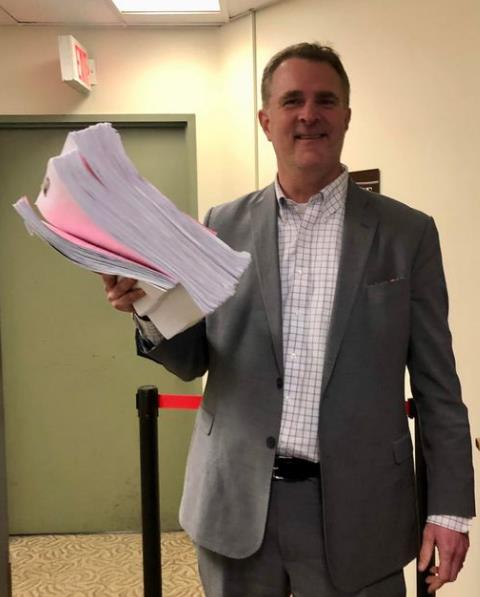
As a result, Sigler found his Lansing home—and all of Tompkins County, for that matter—severed from the Syracuse heart of the redrawn 22nd District, the area where he’d spent much of his time and effort campaigning these recent months. Last week, a new Republican candidate, Cazenovia businessman Steve Wells, entered the Republican race for the 22nd District’s Congressional seat. And in Tompkins County, now placed within a district that extends east to the Massachusetts border, Sigler would have been pitted head to head with a former New York gubernatorial candidate, Dutchess County Executive Marc Molinaro, had Sigler chosen to compete on home turf.
“The lines have changed dramatically and while I’m still a solid candidate, it puts a significant barrier in the way and robs me of several of my main arguments for running in the first place,” said Sigler in a Monday afternoon statement announcing suspension of his campaign. “While I believe I was ideal for the old district, I can’t see a path forward in the new district and I am suspending my campaign,” Sigler added.
As he stepped aside, Sigler endorsed Wells for Congress in the Syracuse-based 22nd District and Molinaro for nomination in the eastern Southern Tier and Hudson Valley district that now includes Tompkins County.
Sigler’s withdrawal marks the second time in 24 hours that a local candidate for Congress has stepped aside. In a Sunday evening statement shared with the media early Monday, Ithaca Democrat Vanessa Fajans-Turner pulled the plug on her own congressional campaign. Fajans-Turner, like Sigler, cited a similar problem; namely a redrawn congressional district that made it tougher for her to compete.
“This new district,” said Ithacan Fajans-Turner of the district in which her county has now been placed, “is very different from the one in which I have been campaigning and building voter trust since launching in February.”
Recognizing Republican Molinaro’s stature in this district, Fajans-Turner added, “I will not act in any way that splits the Democratic field in this new swing district with an established and well-funded Republican in the running. This national moment is larger than any individual candidate, and it is incumbent on all of us to work for the greater, common cause as the stakes of this race continue to rise.”
As it stands at present, neither Tompkins County Republican nor Democratic voters may be offered a Congressional primary this August. Unless additional candidates enter on either side—and assuming 19th District incumbent Congressman Antonio Delgado follows through on plans to resign his seat to become New York’s Lieutenant Governor—only Molinaro will compete for the 19th district’s Republican nomination, and Endicott native Josh Riley for the district’s Democratic nod.
Ironically, it was a Republican-driven lawsuit that did in Mike Sigler’s campaign. After Democratic super-majorities in New York’s Senate and State Assembly drew Congressional and state legislative lines in February to favor their own party’s chances in November, and thrust them through the Legislature on largely party-line votes, Republican plaintiffs challenged those district lines in court. Steuben County State Supreme Court Judge Patrick McAllister upheld the Republican lawsuit in late-March, and McAllister’s holding was later upheld in large part by New York’s highest court, the Court of Appeals.
The Court of Appeals holding, in turn, triggered Judge McAllister to name a special master, Jonathan Cervas, to prepare new congressional and state senatorial maps. Cervas released his preliminary drafts of his maps May 16th. Judge McAllister approved those drafts with only minor changes last Friday.
But for both Sigler and Fajans-Turner, the new districts spelled bad news. If either candidate had chosen to remain in his or her earlier-declared 22nd District contests, they’d have faced the political handicap of competing out of their home territory, and also faced the prospect of being labeled a carpetbagger. For Fajans-Turner, as many as four Onondaga County-based candidates would have been waiting to confront her in the 22nd. And for Sigler, the May 18th entry of Steve Wells, well-known in the new district as a founding partner of the American Food and Vending Corporation, would have made competing in the 22nd an uphill fight.

Moving to home terriroty would not have been much better for either. Fajans-Turner would have faced the better-known and better-financed Riley, who grew up in the Binghamton area now part of the redrawn 19th District. And for Sigler, it would have meant going head-to-head with Molinaro, a former candidate for Governor.
One other option remained possible. Yet, it, too, spelled trouble. Since New York law permits candidates to run outside their home districts, Sigler could have jumped across the Tompkins-Cayuga County line into the new 24th Congressional District. The 24th is a Republican-favored safe-zone, redrawn by Cervas to encompass the northern Finger Lakes and vast swaths of the Lake Ontario shoreline from the St. Lawrence River to Niagara County.
But as a practical matter, conservative Congresswoman Claudia Tenney foreclosed that option Saturday when she, herself, announced plans to run in the 24th. Tenney has plentiful campaign cash, deep-red conservative bona fides, and most importantly, the strong endorsement of former President Trump.
Sources indicate Sigler had firmed up plans to suspend his campaign by the weekend, yet delayed his formal announcement until Monday.
“I don’t feel this was a waste of time,” said Sigler Monday, putting the best face on a disappointing turn of events. “The court could have easily gone the other way. I’m happy they ruled the way they did as we now have much more competitive races in NY,” he added.
“To say I’m grateful for everyone who believed in this campaign and its vision is the largest of understatements I can imagine,” said Fajans-Turner, in her own withdrawal from the congressional race. “We campaigned to drive conversation and engagement around key issues in the community. While our time in this race has ended, our work most certainly has not.”
A Democratic Primary for Congress—if, indeed there is one—would occur August 23rd. Unless either of two candidates drops out before then, Tompkins County Democrats will still have to decide that day their nominee for State Senate, with Leslie Danks Burke and Lea Webb vying for that nomination.
****
Mike Sigler’s Monday afternoon announcement suspending his campaign for Congress was as follows:
Hello,
I want to begin by thanking you for your support in the race for the 22nd district. I jumped into the race February 3rd. I believed, as many of you did, that I was the best candidate for that district, that we would win, and retain the seat against very steep odds. That was always my main goal, to win the seat, and win back the House of Representatives.
The lines have changed dramatically and while I’m still a solid candidate, it puts a significant barrier in the way and robs me of several of my main arguments for running in the first place. While I believe I was ideal for the old district, I can’t see a path forward in the new district and I am suspending my campaign.
Fortunately, the new district is a perfect fit for Steve Wells to run in and win. He has deep ties to both Madison and Onondaga, has run before, and has the means to ramp up a campaign quickly. He was very helpful to me when I first decided to run, introducing me to potential supporters and talking me up.
Thank you for all your support over the past three months. I said I couldn’t do it without the committees and I was proud to gain 100 percent committee support in the gerrymandered district. I don’t feel this was a waste of time. The court could have easily gone the other way. I’m happy they ruled the way they did as we now have much more competitive races in NY.
I will continue to work to elect Marc Molinaro who is now looking to represent Tompkins County and Lee Zeldin and Alison Esposito.
Thank you again for your support and please join your town committee. They are the grassroots. Only you put you on the sidelines. The primary for governor is June 28th. Early voting starts the 18th.
###
Judge approves maps; Tenney moves yet again
by Robert Lynch; May 21, 2022
Fasten your seatbelts. We’re in for a wild ride.
Minutes before Midnight Friday (May 20), the deadline day, Steuben County State Supreme Court Judge Patrick McAllister approved the modified redistricting maps for U.S. Congress and New York State Senate. Reportedly, Judge McAllister made minor adjustments to special master Jonathan Cervas’ submitted maps, initial reports suggest those changes would not affect the districts proposed for Tompkins County or those immediately adjacent to it.
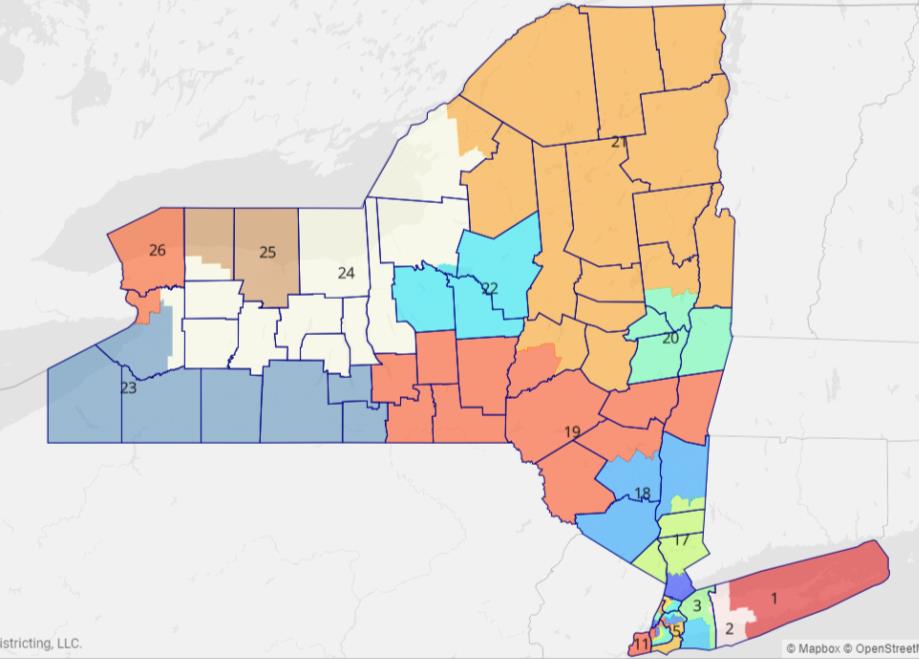
Wasting no time, conservative Republican Congresswoman Claudia Tenney tweeted early Saturday morning that she will move her district of competition this fall yet again, this for the second time. Tenney announced she will run in the new 24th Congressional District, the one that will stretch from the eastern shoreline of Lake Ontario to the western towns of Erie County, and include the nearby counties of Seneca, Cayuga and Yates.
“I’m announcing my candidacy for the new #NY24, which includes areas I currently represent in Congress,” Tenney tweeted at 1:26 AM Saturday. “I’m honored to have received the support of President Trump, (House GOP Conference) Chair Elise Stefanik, and several county Republican chairs,” Tenney continued.
Tenney’s decision appears to have been made on impulse, with little preplanning. As of mid-morning Saturday, Tenney’s campaign website still listed her as a candidate for the Southern Tier 23rd District, represented, until his recent resignation, by fellow Republican Congressman Tom Reed. Tenney hails from the Utica area. Unless maps have been adjusted, her home would not be in either the 23rd or 24th Districts.
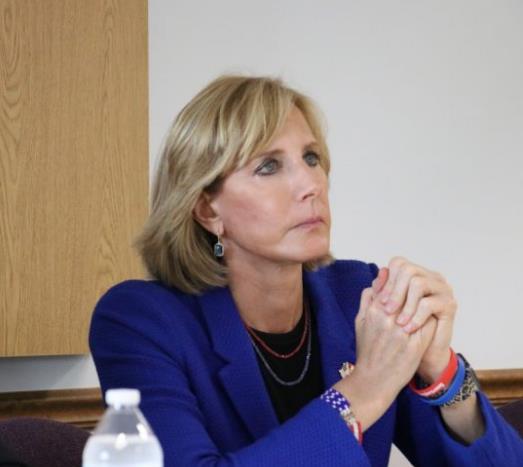
By this latest decision, the Trump-aligned Tenney has placed herself securely in the position of an opportunist, taking her campaign to wherever political pastures look greenest. Beltway commentators call such candidates “mattress-draggers.” And a cynical comic might say Tenney’s mattress has been dragged so much that it should be tossed into Buddy Rollins’ dumpster today at Enfield Clean-up Days.
The final maps approved late Friday by Judge McAllister have yet to be reviewed in detail for minor changes from the special master’s initial submissions, released this past Monday. They’d place all of Tompkins County within a redrawn 19th Congressional district. With Democratic Congressman Antonio Delgado appointed—but not yet officially elevated—to Lieutenant Governor by Governor Hochul, the new 19th would likely have no incumbent for the fall election.
As redrawn by special master Cervas, the 19th District would place Tompkins County as its western anchor. It would stretch east through Binghamton and across the Hudson Riven to the Massachusetts border. The 19th would include Cortland County. In ways, it would resemble the former Matt McHugh/Maurice Hinchey district of decades past.
At present, two Democrats, Josh Riley and Ithaca’s Vanessa Fajans-Turner, have declared for the 19th District’s Congressional contest. Dutchess County Executive Marc Molinaro, a former unsuccessful candidate for New York Governor, has declared on the Republican side.
Lansing Republican Mike Sigler could run in the 19th District for the Republican nomination. But as of late Friday, Sigler’s social media still had him competing in the 22nd District, where Democratic state legislators had initially placed Tompkins County, but from which the special master later removed it following successful court challenges.
If Sigler were to continue to run in the 22nd District, he’d be competing outside of his home district, which remains legal. Were he to sidle into the 19th District, home turf, he’d face Molinaro, a potentially uphill battle.

Meanwhile, in the 23rd District, where Congressman Reed recently resigned, the New York Times reported Saturday that Buffalo-area Congressman Chris Jacobs would compete as the Republican candidate. Democrats this week coalesced around Tioga County’s Max Della Pia for the Democratic nomination for the 23rd District seat.
The Cervas’ maps for State Senate, apparently ratified by Judge McAllister without major change, would link all of Tompkins County with the Binghamton area. There’d be no incumbent. Ithaca’s Leslie Danks Burke and Binghamton’s Lea Web are competing for this new 52nd District’s Democratic nomination. Former Binghamton Mayor Rich David stands as the Republican candidate.
All of this last-minute change comes following the Court of Appeals ratification in late-April of Judge McAllister’s earlier ruling in a Republican-brought lawsuit that struck down redistricting maps drawn by the Democrat-dominated New York state Legislature as unconstitutional. Primaries for the redrawn districts will happen August 23rd.
The downstate website the Gothamist, provides the statewide perspective.https://gothamist.com/news/court-finalizes-new-ny-congressional-state-senate-maps
###
Inflation Hits Enfield Road Projects Hard
by Robert Lynch, May 20, 2022
The cost of rebuilding an Enfield road just went up… and by a lot.
Though the national inflation rate may be running at 8.3 per cent, revised estimates Enfield Highway Superintendent Barry “Buddy” Rollins put before his Town Board this month project his department’s road construction costs may rise by several multiples of the national figure.

In one notable instance, the planned 1.2-mile resurfacing of Harvey Hill Road just west of Route 327, Rollins revised estimates project a 71.4 per cent increase—from $140,000 to $240,000—since his original projections were approved by the Board in January.
For another road slated for upgrade this year, a one-mile stretch of East Enfield Center Road between South Applegate Road and Enfield Center, Rollins projects a 50 per cent increase, from $40,000 to $60,000.
“It’s really the jump in Harvey Hill that caused my jaw to drop,” Councilperson Robert Lynch (this writer), said as Board members, at Lynch’s request, discussed the increases May 11th. Only Lynch voiced serious concerns.
“Well, you want me not (to) do it?” questioned Rollins in response. “I mean that’s all there is to it. I either do it or don’t do it,” he continued. “I’m not going to sit here and argue about the money. The price is the price. And that’s all there is to it.”
The Superintendent’s cost figures came in a so-called “Amended 284 Agreement,” a one-page authorization form named after the section of New York Highway Law which commands it. Once yearly, generally in January, members of all town boards must sign a “284 Agreement” to authorize how much money their Highway Superintendents may spend on local road maintenance… and on which roads. The Agreement provides one of the few legal controls a town board holds over the actions of an independently-elected Highway Superintendent.
Enfield Board members signed the original 284 Agreement Rollins submitted January 12th. The amended document, its totals increased because of inflation, was submitted by Rollins in an email May fourth.
While Rollins assigned certain road projects major increases—the Harvey Hill Road cost increase could be annualized at 171 per cent—the Superintendent’s overall “284” spending would grow more modestly. For reasons never discussed during the meeting, Rollins had reduced by more than 20 per cent his projected expenditures for “General Repairs,” the day-to-day maintenance assigned to no specific road, but rather to Enfield’s 86.2 miles of Town-maintained roads in general. Spending for General Repairs, under the amended agreement, would fall from $145,000 to just under $116,000. The Harvey Hill and Enfield Center Road projects are assigned to a separate category, called “Permanent Improvements.”
Lynch sought and obtained from Supervisor Stephanie Redmond assurances that the Town’s budget could handle the increase.
“We’re actually doing pretty well,” said Redmond of Town finances, though she conceded Rollins’ figures would leave less money in Highway Reserves.
“Mr. Lynch,” Rollins said tersely, “I don’t go over my budget, and the money that I got allocated is in my budget.”
Apologizing to Rollins for “a lot of bad blood” that had spilled between the Town Board and the Superintendent in the past, Lynch said he was only pursuing curiosity as to why, with single-digit annual inflation nationally, one road project had risen by over 70 per cent in five months.
“If you take fuel costs alone,” replied Redmond, “the inflation is a lot higher.”
“Not 71.4 per cent,” Lynch answered. “Not in five months. My cost of gas hasn’t gone up that much.”

At Lynch’s urging, the Town Board passed a largely-symbolic resolution to accept the Superintendent’s changes. It included Lynch’s stipulation that Rollins “will not spend the entire amount if he does not need to.” Though the law requires members only lend their signatures, the Enfield Board has of late preferred to back up those signatures with official action.
Estimates Rollins provided under the 284 Agreement apportion Highway Department spending only by road. Rollins need not provide a detailed cost breakout, and he did not. The superintendent stated the estimates calculate only maximum costs, not necessarily what he will spend.
****
The Enfield Town Board spent money in other ways that Wednesday night. As the second act to a contentious Board discussion in April—yet one far more placid this time—the Town Board unanimously voted to award contracts for installation of heat pumps on the upper floor of the Town Courthouse, where the Town Justice holds court and the Town Board conducts in-person meetings.
The multi-stage project, made far more complex and expensive by environmental rules, would cost nearly $46,000. Supervisor Redmond assured the Board a State grant will cover the expense.
Though the heat pumps’ contractor would charge less than $18,000, the project’s price tag was raised significantly by the need to reinsulate the Courthouse attic and remove the existing vermiculite insulation through asbestos-abatement protocols. Indeed, the asbestos abatement became the costliest expense.
Councilperson Lynch, who strongly opposed the Courthouse project a month earlier, supported awarding the contracts this time. Given the Courthouse building’s uncertain future, Lynch reiterated his own reluctance. But he yielded to the Board’s majority opinion that the project should proceed, concluding the matter had been settled.
In other business:
- The Town Board considered, but then tabled, Councilperson Lynch’s initiative to alter a 12-year old practice governing how Enfield receives its share of Tompkins County sales Tax revenue. Since 2011, the Town has chosen to credit Sales Tax receipts to reduce the County’s share of Property tax, rather than take the money directly.
While direct payment of Sales Tax could simplify Town budgeting in this tight financial year, Lynch acknowledged he’s had second-thoughts about his idea, after learning the proposed change may reduce Enfield’s share of so-called “PILOT” revenues received from solar farms. “We don’t want to cut off our nose to spite our face,” the Councilperson said.
The Sales tax change will head to the Town’s Finance Committee for more study.
- And as to solar farms themselves, the Town Board, following a sparsely-attended Public Hearing, continued for an additional six months a Town-wide moratorium on approval of new commercial solar installations. The Board imposed the moratorium last December to permit a committee to study changes that could bring the Town more revenue from future solar farms. “I’m in favor of extending so we can get it all done and done right,” said resident Marcus Gingerich, the hearing’s only commenter.
###
Ithaca School Board certifies “mess” of an election
by Robert Lynch, May 19, 2022
Maybe Board of Education member Christopher Malcolm put it best: “Really, we understand that this was a mess.”
Malcolm’s colleague, Nicole LaFave was less forgiving: “I personally feel like maybe it wasn’t intentional, but there was voter suppression.”

Despite the apologies, criticisms, excuses— and most noticeably, LaFave’s abstention—the Ithaca School Board Wednesday evening (May 18) certified the results of the district’s election of a day earlier, a seven-way contest for four Board seats that sparked an unusually high turnout, elected newcomers as its two top vote-getters, and saw long-time Board President Robert Ainslie ousted, Ainslie finishing the election second to last.
With one member (Dr. Patricia Wasyliw) excused and a second seat left vacant by a prior resignation, six of the Board’s remaining members, absent LaFave, certified Tuesday’s results as valid even though a trifecta of errors election day had strained the credibility of an educational institution that teaches—or at least, should teach—its charges to get the right answer the first time.
State law required the School Board to validate Tuesday’s election results by 8 PM Wednesday. And based on the meeting’s advice from the school district’s attorney, Kate Reid, the Board had little choice but to do so, mistakes or not. Had the Board not certified, or had it otherwise questioned the results, only the State Education Commissioner could have resolved the matter.
“I can share with you that our legal representation has shared with us that the election is completely valid,” Superintendent Dr. Luvelle Brown counseled the Board Wednesday. Brown added, “There were no concerns from our school district attorney’s perspective that there are issues that need to go to the Commissioner or any issues around the invalidation of this particular election.”

But issues there were. And whether Tuesday’s errors, taken in their totality, place the voters’ will in doubt remains a subjective decision very much a matter of personal opinion.
Critics to Wednesday’s vote cite three problems in particular. At some polling locations early in the day, signs instructed voters to select three candidates, not the correct number, four. Poll workers ran out of ballots at one or more sites, as district officials had not anticipated the heavy turnout. And the status of disqualified Board candidate Benjamin Mumford-Zisk rested on shifting sands throughout the day. Signs first stated that Mumford-Zisk had withdrawn from the election. Later, they were changed to indicate that he had failed to meet the district’s one year, continuous residency requirement and had become ineligible to serve.
“Before I vote, I need to know that that election isn’t void given everything that happened,” said LaFave. Members, including LaFave, requested, and got, attorney Reid’s explanation, a rapid-fire, far-reaching legal overview that consumed half of the 44-minute meeting and ended with Reid concluding that any errors committed were likely only harmless and not fatal to the final result.
But the inference drawn from Tuesday’s “Lake Street Fiasco”—if one might call it that—is that a patchwork of confusing state laws coupled with an absence of responsibility and accountability by those who should have known better had left election machinery to run on its own that day, with no one truly in charge… and without the Board of Elections to serve as the grownup in the room.
“We do not oversee the election, nor does Central Administration,” stated Board member Moira Lang at an early point in the meeting, probably speaking in error. “As I understand it,” Lang said of election responsibility, “it’s the Board Clerk, in consultation with the Board of Elections. This is not something we run.”
Well, not exactly, attorney Reid responded, at least not when it comes to rejecting candidate Mumford-Zisk as ineligible.
“Sometimes, the Education Law doesn’t make a lot of sense, guys,” Reid counseled the Board. “It’s scripted. A lot of these laws are 100 years old. It’s not intuitive. You can’t shoot from the hip on it.”
For example, the laws governing rural, central school elections place candidate vetting responsibilities with the District Clerk. Small City School Law places Ithaca’s with the Board of Education. And whereas the Ithaca Board is not necessarily required to vet candidates, it must disqualify a candidate once the Board learns he’s ineligible, Reid stated.
Superintendent Brown, later, in response to LaFave’s inquiry, advised the Board he’d only learned of Mumford Zisk’s ineligibility at 10:15 PM on election eve.
As to LaFave’s other major concern, the attorney made it clear that district employees or volunteers, quite clearly, had failed to think. Last year, only three Board seats were up for election. This year, because of a vacancy, the number had risen to four. Staff thoughtlessly, routinely posted last year’s signs.
“I was personally upset by that development when I learned that those posters had been posted,” Reid told the Board, clutching her throat, “because I can appreciate 100 per cent, as a taxpayer and a voter why people would have been confused.”

Confused, perhaps, but Reid concluded, not to the point of invalidating the election.
“But the School Board is human, right?” the attorney continued. “This election is being run by human beings; by people, largely retirees, who are coming out to help us with this, and there’s a margin of human error involved in that.”
Reid acknowledged her research had found no legal precedent for how the law handles such posted misinformation. Yet she doubted a legal challenge would succeed. First, she said, the posting was “relatively limited,” maybe for two hours or less. Secondly, she said, the ballot, itself, was accurate.
“There was no intentional attempt to disenfranchise voters here,” Reid concluded. “This was a minor oversight.”
The mix-up over the Mumford-Zisk candidacy’s ever-changing ballot status may, in truth, have been the candidate’s own fault. Reid claimed her colleague had contacted Mumford-Zisk at about Noon on Tuesday and informed him of his ineligibility. Mumford-Zisk, in turn, “represented to her that he was withdrawing his candidacy.”
But at about 3:30 Tuesday afternoon, with the election well underway, an attorney for New York State United Teachers called Reid to inform her that the candidate had “changed his mind” and “was not planning, in fact, to withdraw his candidacy.” School officials then realized that their earlier-posted signs stating Mumford-Zisk’s withdrawal were “materially inaccurate.” They replaced them with signs that explained his ineligibility instead.
It would have been a “circumvention of the democratic process,” said Reid, for the district to allow the election to proceed without notifying voters of the candidate’s disqualification. Mumford-Zisk, if elected, could not have been seated. The School Board would have needed to appoint a replacement. Election results could have faced a greater chance for legal challenge, she argued. Furthermore, the appointment, Reid said, would have been “anti-democratic.”
But when assigning blame for the multi-faceted errors at Ithaca School District polling places, quite clearly, the Board of Elections becomes an innocent observer. Because New York places school election administration under the Education Law, and not the Elections Law, it relegates the Board of Elections only to the background.
“They (the school districts) give us lists of candidates,” Tompkins County Deputy Elections Commissioner Elizabeth Livesay said Thursday. “We use an election management system to print the ballot.” District officials then, said Livesay, “give us a thumbs up or thumbs down,” on the ballot created. The district makes changes, when needed. Then, Livesay continued, the elections board creates the ballot’s “final scannable version” and provides it to the schools, along with pre-tested voting machines.
Addressing the issue of Mumford Zisk’s disqualification—based on a residency requirement set by the Ithaca District, not by the State or the Board of Elections—Livesay made it clear. “We don’t get into the legalities of who’s eligible for the ballot.”
Though Board member Lang may have been technically correct when she said that the Board, itself, does not run its own election, the Board’s Clerk, by contrast, assumes a pivotal role. And LaFave pressed Superintendent Brown as to whether the Board Clerk should have vetted residency eligibilities, including Mumford Zisk’s, in advance.
“The Board Clerk assumes they are residents based on their affirmation as part of the documentation they hand in,” Brown responded.
President Ainslie weighed in, noting the candidates’ packet clearly states the residency requirement on its face.
“The fact that someone did not read it, which was perhaps the case, that’s not the Board Clerk’s obligation, to have you stand there and read it,” said Ainslie.
Ainslie, president of the Ithaca School Board since 2008, will depart next month, unless, as is unlikely, Tuesday’s elections get overturned. Attorney Reid indicated a voter could still petition for the Education Commissioner’s review. Ainslie finished sixth in Tuesday’s voting, falling one vote behind the disqualified Mumford-Zisk.
Newcomers Karen Yearwood and Jill Tripp led the pack in Tuesday’s balloting, Yearwood securing 2,799 votes; Tripp 2,604 votes, respectively, each earning a full, three-year position. Incumbents Erin Croyle (2,584 votes) and Eldred Harris (1,292 votes) secured the remaining two Board spots, though Harris must settle for a two-year appointment to fill the remainder of a Board vacancy created by Kelly Evans’ earlier resignation.
Less controversial, Ithaca District voters handily approved a nearly $149 Million 2022-23 District Budget Tuesday; the vote 2,446 votes to 1,069. Voters also authorized two other spending propositions, each by wide margins. However, they rejected a fourth proposition, more controversial, that would have conveyed a small parcel adjacent to the Beverly J. Martin Elementary School downtown to the City of Ithaca to enable expansion of the Greater Ithaca Activities Center’s Gymnasium.
###
Revised Senate maps would keep lines close; races unchanged
by Robert Lynch, May 17, 2022
Some five hours after court-appointed special master Jonathan Cervas’ proposed redistricting maps for Congress on Monday (May 16; see separate story), the maps for Cervas’ other assignment, redistricting the New York State Senate, became public. But whereas the special master’s Congressional map revisions would force a major course correction in local campaigns, the comparable map changes for State Senate in Tompkins County would hardly make a difference.
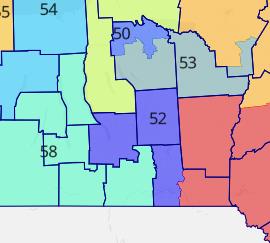
While Cervas’ State Senate map would renumber Tompkins County’s District from 53 to 52, the redesign would still place Tompkins County within a single State Senate district—something local leaders have long sought, but have not enjoyed for several decades. Even more importantly, the special master’s revision would keep current party primary match-ups intact. Those contests took shape after the State Legislature in February adopted the initial district maps that courts later rejected as unconstitutional.
“Can’t wait to get to work for the… district, NY52,” Democratic candidate Leslie Danks Burke tweeted to her followers late Monday.
In an email message to prospective supporters, Danks Burke’s primary opponent, former Binghamton City Councilperson Lea Webb, shared the same optimism.
The district’s Republican candidate, former Binghamton mayor Rich David, faces no primary challenge, but also stands unaffected by the redrawn lines.
Webb and Danks Burke had stood as the only remaining candidates in the district’s Democratic field when the New York Court of Appeals on April 27th invalidated as unconstitutional the lines the State Legislature had earlier drawn. The Court’s action set in motion procedures under which a lower judge appointed Cervas, a postdoctoral fellow at Carnegie Mellon University, to be special master and redraw the lines consistent with constitutional commands and submit Congressional and State Senate maps for the judge’s approval within the next week.
While Cervas’ State Senate revisions hold little impact for residents in Tompkins County, they will affect some of the county’s neighbors. Whereas, the Legislature’s maps had split Cortland County between two Senate districts, the special master’s revision would unify Cortland County within the single district, one that would also represent those in Tompkins.
But in his cutting and pasting to create his population-balanced 52nd District, Cervas would chop away parts of eastern of Tioga County, towns that the Legislature’s plan had earlier included within it.

Both the Legislature’s and Cervas’ maps would slice Broome County down the middle, splitting its representation. Slight differences lie between the two maps. Nonetheless, the special master’s plan would likely retain within the proposed, renumbered 52nd District the City of Binghamton, home-base for both Webb and David.
“Yesterday… we learned that all of Tompkins County will be part of the new State Senate District 52, which also encompasses much of Broome County and all of Cortland County,” wrote candidate Webb Tuesday. “We have much in common as a community and district, and I’m glad they’ve kept us together.”
Steuben County State Supreme Court Judge Patrick McAllister will decide within days whether the special master’s maps meet his court’s standards for political neutrality. But since the judge—and Cervas—have taken the drafting pen away from legislative Democrats and their super-majorities, the lines drawn will likely yield Democrats fewer Senate seats this fall than the controlling party had expected.
Kate Lisa of Spectrum News reported Monday of the Senate districts Cervas had drawn, 38 lean toward Democrats, ten toward Republicans, and 15 remain competitive. In the current Senate, 43 members are Democrats, 20 Republicans.
In one respect, however, Cervas’s maps, like those of the Legislature earlier this year, fulfill a separate, distinct goal of local Democratic leaders. Whereas Tompkins County’s representation for at least a decade has been split among three State Senators—none of them living locally and all of them Republican—the special master’s proposal would continue the Legislature’s intention to place all of Tompkins County within a common Senate district.
Moreover, the Cervas plan would take Tompkins County’s request one step further; merging all of Tompkins County with all of Cortland County as part of District 52.
In testimony to New York’s ill-fated and politically-torn Independent Redistricting Commission last year, one prominent Democratic voice, now-retired county legislator Martha Robertson, had urged the unified, two-county linkage. Robertson argued that both Tompkins and Cortland counties deserve a common State Senator (and Congressperson) since they share many “communities of interest,” including a jointly-funded community college. Democrats in the State Legislature failed to tie Tompkins County with all of Cortland County, but the special master’s plan would do so.
Only the redistricting of seats for Congress and the State Senate fell within special master Cervas’s assignment. Despite citizen challenges, courts have left district lines for the State Assembly unchanged from those the Legislature struck in February.
###
Redrawn Congressional Map would bond us with Binghamton, not Syracuse

by Robert Lynch, May 16, 2022; additional reporting, May 17th at 12:30 AM
Surprise! Remember the old “Maurice Hinchey” Congressional District we in Tompkins County used to be part of before we were tied to western Southern Tier counties stretching to Lake Erie? Well, what’s old may be new again.
A special master overseen by the Bath-based judge who three months ago threw out Democratically-drawn redistricting maps for Congress and the New York Senate released his draft redesign Monday. And whereas the Democrats’ plan, adopted by the State Legislature amid controversy, would have linked Tompkins County with Syracuse in a blue-tinted district that favored New York’s majority party, Jonathan Cervas’ redesign would sever Tompkins County from places to the north, and tie it with an eastern Southern Tier and Catskill Region string of counties, a district much more politically diverse and competitive.
Instead of being within the New York 22nd District, Tompkins County would find itself in the 19th District, whose only incumbent, Democratic Congressman Antonio Delgado, has been tapped by Governor Kathy Hochul to be Lieutenant Governor. All presumed Delgado would give up his seat in Congress to become New York’s second in command. At this early writing, Delgado’s political options remain uncertain.
Should Delgado not be in the mix, the Democrats’ prime beneficiary could be Josh Riley, who’d edged to a leading spot in the crowded, six-way contest for the previously-drawn Syracuse/Ithaca-based district. Riley hails from Endicott, within the newly-redrawn NY-19th, and the line changes could allow Riley to shed the potential handicap as a carpetbagger.
Ithaca resident Vanessa Fajans-Turner would also be running in the 19th District contest. Tioga County’s Max Della Pia, who would also reside within the 19th, will, according to media reports, continue his pursuit of the 23rd District seat, currently held by retiring (and recently-resigned) Republican Congressman Tom Reed. Della Pia would do so even though he would no longer live in the district he seeks to represent.
On the Republican side, Lansing’s Mike Sigler could be the big loser, though Sigler could still run in the Syracuse-based 22nd District, drawn by special master Cervas to include Onondaga, Madison, and Oneida Counties. Sigler has strong Syracuse ties and has campaigned heavily in the Salt City region in recent months.

Should he compete on home turf in Tompkins County though, Sigler could face stiff head winds, as media reports indicate former gubernatorial candidate Marc Molinaro, who had planned to run against Delgado, remains eyeing the seat. Molinaro lives in the Hudson Valley region and already has strong name recognition.
A check of Sigler’s social media pages Monday evening failed to disclose the candidate’s current plans.
Special master Cervas’ proposed lines remain subject to revision before State Supreme Court Judge Patrick McAllister signs off on them. Judge McAllister is set to decide on the Congressional maps May 20th. Monday’s early disclosure caught some by surprise.
Overall, Cervas’ redrawn lines would erase much of the earlier advantage Democrats had hoped to achieve by usurping redistricting responsibility from a constitutionally-mandated New York Independent Redistricting Commission in early-February. Yet the Cervas draft would place district borders much more along county lines than would have the State Legislature’s design. As such, the Cervas plan looks to the naked eye much less like a gerrymander.
If the special master’s plan becomes Judge McAllister’s final choice, Tompkins County would become the 19th Congressional District’s western anchor. Cortland County would be part of the district, as would Tioga, Broome, Chenango and Delaware Counties. The 19th District would stretch all the way across the Hudson River to the Massachusetts border.
****
Congressman Delgado, who’s elevation to Lieutenant Governor—if one would call it that—would require his nearly simultaneous resignation from Congress, is not the only New York Congressperson scratching their heads and weighing their options. So, too, is Congresswoman Claudia Tenney, the Trump-friendly Republican from Oneida County, who’d seen her seat redistricted away by Democrats, but now might have reason to stay put.

After Democrats imposed their legislative will in February, Tenney announced her plans to succeed Congressman Reed in the Southern Tier 23rd District. But with the Onondaga-Oneida 22nd District made more competitive by Cervas, Tenney might choose to remain on home turf. And should Lansing’s more moderate Sigler compete in the 22nd as well, a primary slugfest could result.
But the primary contests upstate could pale in comparison to those in and near New York City, as special master Cervas’ maps have placed high-profile Congressional Democrats in celebrity match-ups. As Nicholas Fandos reported on deadline Monday in the New York Times:
“The most striking example came from New York City, where Mr. Cervas’s proposal pushed Representatives Jerrold Nadler, a stalwart Upper West Side liberal, and Carolyn Maloney of the Upper East Side into the same district, setting up a potentially explosive primary fight in the heart of Manhattan. Both lawmakers are in their 70s, have been in Congress for close to 30 years and lead powerful House committees.”
Fandos continued: “Representative Hakeem Jeffries, the chairman of the House Democratic Caucus and a favorite to become the party’s next leader, was one of a handful of incumbent lawmakers who, under the new map, would no longer reside in the districts they represent…. In a blistering statement, Mr. Jeffries accused the court of ignoring the input of communities of color, diluting the power of Black voters and pitting Black incumbents against each other in ‘a tactic that would make Jim Crow blush.’”
“The draft map released by a judicial overseer in Steuben County and unelected, out-of-town special master, both of whom happen to be white men, is part of a vicious national pattern targeting districts represented by members of the Congressional Black Caucus,” Mr. Jeffries wrote, according to the Times’ report.
The New York Court of Appeals designated Jonathan Cervas, a postdoctoral fellow at Carnegie Mellon University, to draw the presumptively less partisan maps for New York’s Congressional and State Senate Districts after the Court held April 27th that districts Democratic-majority state legislators drew in February violated the New York Constitution on both substantive and procedural grounds. Most observers saw the legislative takeover of the process as a bold-faced gerrymander; an attempt to net Democrats as many as three additional House seats.
But the special master’s maps of Monday would erase those gains. By Cervas’s own account, the Times reports, his design would create as many as eight competitive seats to represent New York in Congress. The Democrats’ maps would have yielded only three.
In upstate New York, gerrymandering’s most egregious example was the proposed 24th Congressional District, engineered, transparently, to “pack” as many Republicans into it as possible. Rather than follow logical county lines, the Democrats’ 24th District would have zig-zagged along a jagged boundary and hugged the southern shore of Lake Ontario over much of the way from the Saint Lawrence River to near Niagara Falls.
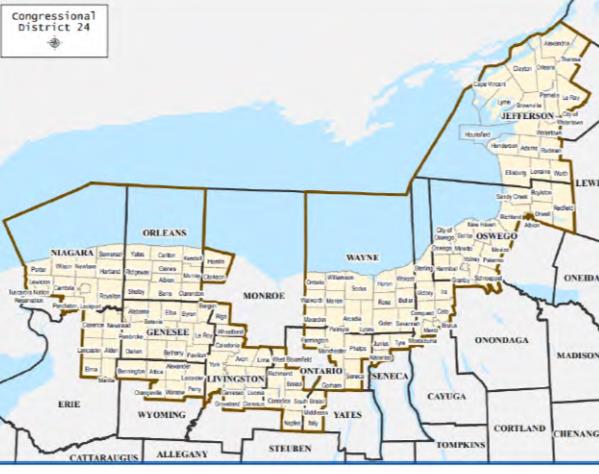
As redrawn by the special master, the new 24th would begin, again, near Watertown, but travel more logically south through the Finger Lakes and then west to just past Batavia. It would leave the western Lake Ontario shoreline to Rochester- and Buffalo-based districts. The redrawn 24th District, unlike its predecessor, would not strain the limits of contiguity.
Special master Jonathan Cervas, according to media reports, has declined to comment on his work product prior to its approval by Judge McAllister.
The judge has already delayed party primaries for Congress and State Senate from late-June until August 23rd because of the redistricting litigation.
###
Enfield Planners nix energy- aggressive building code
by Robert Lynch, May 4, 2022
Newfield’s adopted it. Dryden has too. But barring a serious change of heart, the Town of Enfield will likely take a pass on imposing a new, more energy-efficient building code that’s been promoted by State environmental interests.
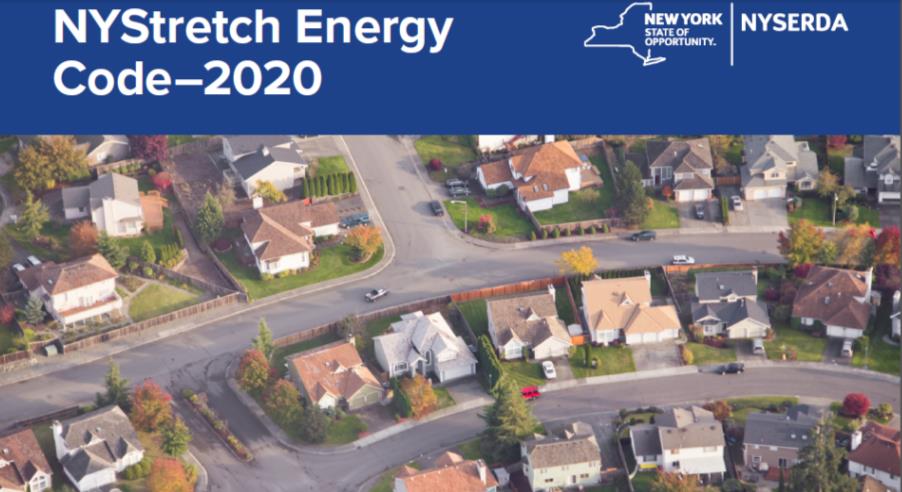
Whereas the Enfield Town Planning Board gave the “New York Stretch” code a cool reception when the Board first considered it in early-April, the greeting was downright icy Wednesday (May 4th) as town planners rejected the package of potential regulations after just seven minutes of discussion and without even taking a formal vote.
“It’s problematic. It was not thought out that well,” said Planning Board member Mike Carpenter, the Stretch Code’s lead critic.
Although the Enfield Town Board could overrule its Planning Board and embrace NY-Stretch without planners’ endorsement, Town Board members stand unlikely to do so. At least one Councilperson has deemed the planners’ approval as critical to any future support he might give.
Going as far back as 2020, energy-conserving advocacy agencies, like NYSERDA, have encouraged municipalities to incorporate tougher “Stretch” standards within their own building codes. Stretch’s provisions would require home builders to install more energy-efficient windows, shorter pipe runs to water faucets, and most controversially, electricity breaker panel capacity and conduit runs to accommodate future solar panels on the rooftop and electric cars down the driveway.
The Newfield Town Board, with one dissent, adopted New York Stretch last August. Carpenter told the Planning Board the Town of Dryden has approved Stretch as well. But in Dryden’s case, said Carpenter, the Town’s Building Inspector wishes it hadn’t.
“They had to do very selective enforcement,” Carpenter told Wednesday’s meeting concerning Dryden’s experience, “because some things are not enforceable.”
The Town of Danby, Carpenter further reported, is “considering” Stretch, but is unlikely to adopt it.
“I don’t think it’s worth the Town’s time to pass it,” Planning Board Chair Dan Walker remarked, counseling the Enfield Board to set Stretch aside. It would only create “more confusion for the Codes Enforcement Officer,” Walker concluded.
For one thing, said Walker, the code imposes “a lot of nit-picky things.”
Town Supervisor Stephanie Redmond had initially targeted the Stretch Code for adoption before June first, Redmond noting that NYSERDA was offering towns $5,000 to $10,000 in grant money if it adopted the code before the June deadline. But Redmond in late-April pulled the item from the Board’s May 11th agenda. Given Wednesday’s Planning Board rejection, NY-Stretch stands unlikely to return to an agenda anytime soon.
Key to Redmond’s and other Board members’ decision for delay was an April 28th memo Carpenter wrote the Supervisor, and that Redmond quickly shared with her Board. In that lengthy memo, Carpenter—a builder, whose family installs solar systems—described the Stretch Code as “an amalgam of energy saving ideas that are somewhat disparate in their focus.”
“The actual energy savings from them,” wrote Carpenter of the code’s new standards, “will be in the 1 percent or less range, and will likely have a payback period in decades rather than just years. Some of these will come (into later adoption) with the new code, likely out in a year or two, and some may not ever be written into code. There is value in them, though certainly nowhere near the claim of 25 to 30 percent cost savings.”
“My conclusion,” Carpenter wrote, “is that the difficulties in implementing and enforcing this code make it questionable that the town should adopt it. I have heard that it will save significant energy and cost little extra money. My own opinion is that the opposite is more likely to be true.”
Instead, Carpenter’s suggestion—a point he reiterated to the Planning Board Wednesday—is that Enfield write its own, likely-voluntary, energy-saving building code, one that might embrace the good parts of NY-Stretch and cast aside the rest.
“The folks who wrote the Stretch Code are not that experienced in building,” Carpenter told the Planning Board. “They don’t understand that something that is very expensive might not have much impact.”
To at least one Town Board member, namely this story’s writer, the absence of Planning Board endorsement of NY-Stretch constitutes, for him, a deal-breaker.
“In all matters of land management and building regulation, we should give both our Planning Board and our Codes Officer great deference,” Councilperson Robert Lynch wrote in an April 29th email to the Town Board, responding to Carpenter’s concerns. “To ignore their input is to disrespect their authority.”
“Yes, we, the Town Board, hold the final say,” Lynch acknowledged. “But until the Planning Board recommends we adopt New York’s Stretch Code, I would not vote in its favor.”
****
With the Stretch Code dispatched, the Enfield Planning Board went on with its Wednesday meeting. For the next three-quarter hour, it continued to review and update town subdivision regulations. Near the meeting’s close, an un-pictured viewer of the online meeting, identifying herself as “Eileen,” a teacher, offered an idea. She suggested that any new subdivision provide a bus shelter for school children.
“It’s a safety issue,” Eileen insisted. The Board responded approvingly to Eileen’s suggestion.
###
Lane to Putin: Look for the “Nazi” in your Mirror
by Robert Lynch; Posted May 4, 2022
The masks were back on, but there was no muffling Tompkins County legislator Mike Lane’s anger Tuesday night (May 3rd) as Lane delivered his—always tempered, yet equally-decisive—stern rebuke of Vladimir Putin for the Russian President’s continuing assault on the Ukrainian people and the humanitarian atrocities Putin has committed in his attempts to conquer a freedom-loving neighbor.
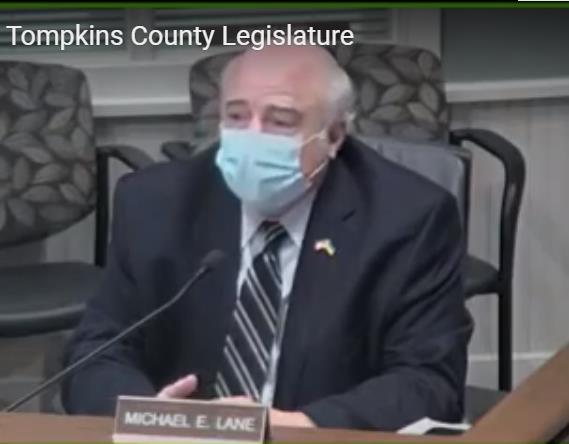
“We know we’re stuck,” said Lane, the Dryden Democrat, adding to the frustration and outrage he’d expressed at prior sessions. “We’d love to put NATO forces in there and clean the clock of those people who are the aggressors.”
“But,” Lane admitted, “the nuclear option; the nuclear deterrent is very real and we understand that.”
What Lane told the Legislature Tuesday has been said by many people in many places at many times in recent weeks. But with the predictable boilerplate behind him, the Legislature’s most senior member launched into a more pointed, personal critique:
“One of the worst things that I’ve heard recently was the (attempt to) belittle President Zelensky who happens to be of Jewish origin, by trying to say—I think Putin or Putin’s people said, ‘Well, Hitler may have had Jewish blood in him.’”
“The Israelis,” said Lane, “were naturally upset and disgusted by those kinds of comments, which belittled the Holocaust. I suggest that if President Putin really wants to see a Nazi, he ought to walk over to his mirror in the morning and take a good, hard look, because he’s following Adolph Hitler’s playbook in the Sudetenland and everywhere else.”
The Sudetenland was a portion of the former Czechoslovakia that Hitler annexed to Germany in 1938 as a prelude to World War II.
Lane told the Legislature he’s flying the Ukrainian flag at his home. He said many of his Dryden neighbors fly that flag as well.
“I wish that there was more that we could do,” Lane lamented. “But I understand it,” he acknowledged near the close of his somber, three-minute monologue. “It eats away at me as an American. Flying the flag is very little that we can do. But if folks can contribute to helping these folks… the refugees and the other people who are trying to flee from their own community because of the death and destruction, I hope they do that.”
Lane went on to announce happier news, the appointment of Amy Kremenek as the new President of TC3. (See separate story, posted on this website.) Several seconds of silence followed the conclusion of Lane’s legislative floor privilege. No other member added to his comments on Ukraine. The County Legislature moved on to its other business.
Among that other business:
Podunk Road Bridge: Without one word of discussion, and relegated to the catch-all “Consent Agenda,” the Legislature approved replacement of the narrow, steel-grate Podunk Road Bridge over Taughannock Creek. The more than $3.5 Million project would realign the bridge to avoid the road’s sharp curve and replace the “single span steel truss bridge” with one of “prestressed concrete box beams on concrete abutments.”
Though technically a two-lane structure, two cars rarely pass on the aging Podunk Road Bridge. Presumably its replacement would be one of modern, two-lane width. Legislative documents claim the old bridge is in “poor condition,” and that a state inspection warned of “significant structure deterioration.”
Nonetheless, one might anticipate neighborhood concern, especially when one recalls the ongoing controversy that’s arisen in recent years over replacement of a somewhat-similar structure, the Freese Road Bridge in Varna, discussion that prompted a Town-County standoff over what sort of bridge should replace Varna’s historic, one-lane structure.
As yet, no similar controversy has arisen over the Podunk project. And the County Highway Department has yet to assess the old bridge’s historic significance. Ulysses Legislator Anne Koreman indicated Wednesday that the public will have “several built-in opportunities to weigh in” on the project.
****
Tompkins County SIREN: Tompkins County Emergency Response Director Michael Stitley and the Department’s Community Preparedness Director, Geoff Dunn, briefed the Legislature on the County’s transition from its former “SWIFT-911” mass notification system to what County wordsmiths have dubbed “Tompkins County SIREN,” an acronym standing for “Safety and Incident Real-Time Emergency Notifications.”

Hype and rebranding aside, the world of corporate buyouts truly prompted the transition. “RAVE Mobile Alert” bought out “SWIFT Reach.” It then chose to replace SWIFT’s technology with its own.
“RAVE Mobile Alert,” said Dunn, “is in the process of transitioning the SWIFT customers to the RAVE Alert product. So rather than being told we had to move, we figured now was the time to just make the transition.”
The County began that transition back in March. “Up until now, it’s been a soft launch,” Dunn told the Legislature. But SIREN’s “coming out party,” as it might be termed, was the recent mass mailing of giant postcards to every county household. Bus cards and business cards added to the effort. In response to legislator Randy Brown’s question, Dunn said the mailing alone cost the County $15,000. A second may occur in September.
But the transition carried with it some occasional fumbles.
“While it is true,” said Dunn, “and we did specify in some of our early literature, that the SWIFT-911 information had been carried over to SIREN; transitioned… the user must still go in and create a profile and account within SIREN.”
There’s a reason for that, and the Preparedness Director conceded it’s not just because some SWIFT phone numbers and email addresses are outdated. “The SWIFT lists,” Dunn revealed, “will sunset at the end of the year and will no longer be used.” Earlier advisories had never told us that. Existing users were wrongly led to believe they’d need to do nothing.
What’s more, SIREN’s signup occurs through the Tompkins County website or via text message, perhaps not the easiest task for the computer-compromised.
Yet, legislator reaction was overwhelming positive. “This is really good work,” Dryden’s Greg Mezey said of the promotional rollout. “This is impressive. I think it is worth every penny.”
###

